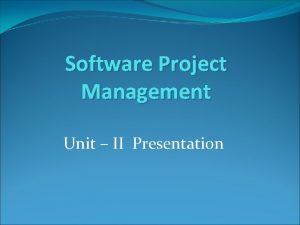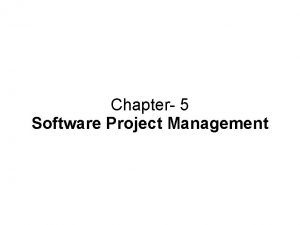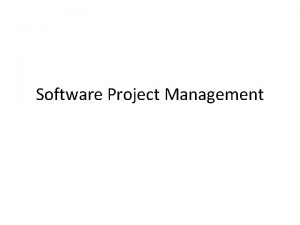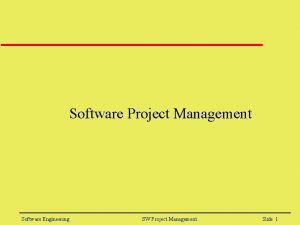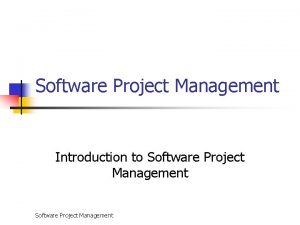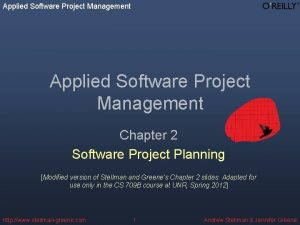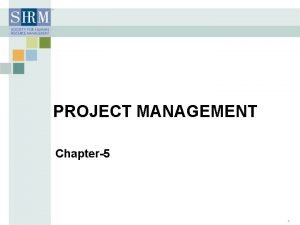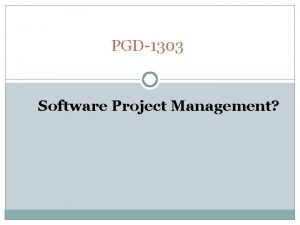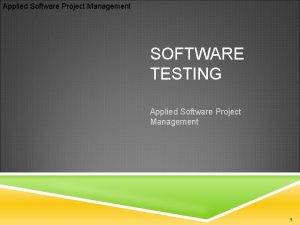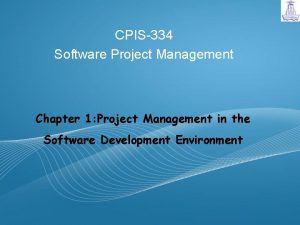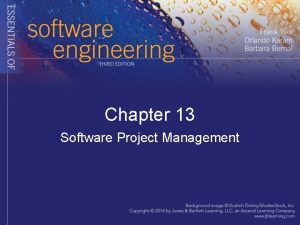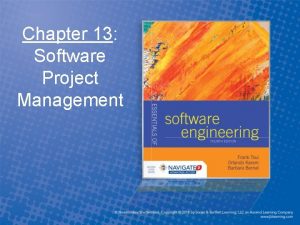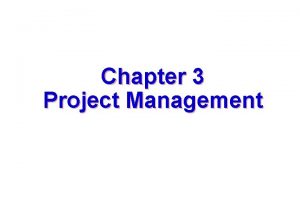Software Project Management 4 th Edition Chapter 9





















- Slides: 21

Software Project Management 4 th Edition Chapter 9 Monitoring and control 1 ©The Mc. Graw-Hill Companies, 2005

The control cycle 2 ©The Mc. Graw-Hill Companies, 2005

Responsibilities 3 ©The Mc. Graw-Hill Companies, 2005

Assessing progress Checkpoints – predetermined times when progress is checked – Event driven: check takes place when a particular event has been achieved – Time driven: date of the check is pre-determined Frequency of reporting The higher the management level then generally the longer the gaps between checkpoints 4 ©The Mc. Graw-Hill Companies, 2005

Collecting progress details Need to collect data about: • Achievements • Costs A big problem: how to deal with partial completions 99% completion syndrome Possible solutions: • Control of products, not activities • Subdivide into lots of sub-activities 5 ©The Mc. Graw-Hill Companies, 2005

Red/Amber/Green reporting • Identify key tasks • Break down into sub-tasks • Assess subtasks as: Green – ‘on target’ Amber – ‘not on target but recoverable’ Red – ‘not on target and recoverable only with difficulty’ • Status of ‘critical’ tasks is particularly important 6 ©The Mc. Graw-Hill Companies, 2005

Gantt charts 7 ©The Mc. Graw-Hill Companies, 2005

Slip charts 8 ©The Mc. Graw-Hill Companies, 2005

Ball charts Code and test module A 10/10/05 21/10/05 23/10/05 Code and test module B 14/10/05 17/10/05 27/10/05 31/10/05 17/10/05 Code and test module C 27/10/05 7/11/05 9 ©The Mc. Graw-Hill Companies, 2005

The timeline 10 ©The Mc. Graw-Hill Companies, 2005

Cost monitoring • A project could be late because the staff originally committed, have not been deployed • In this case the project will be behind time but under budget • A project could be on time but only because additional resources have been added and so by over budget • Need to monitor both achievements and costs 11 ©The Mc. Graw-Hill Companies, 2005

Earned value analysis • Planned value (PV) or Budgeted cost of work scheduled (BCWS) – original estimate of the effort/cost to complete a task (compare with idea of a ‘price’) • Earned value (EV) or Budgeted cost of work performed (BCWP) – total of PVs for the work completed at this time 12 ©The Mc. Graw-Hill Companies, 2005

Accounting conventions • Conventions – 0/100 nothing allocated on start of activity, 100% on finish – used here – 50/50 half allocated at start, the other half on completion – Milestone current value depends on the milestones achieved • Can use money values, or staff effort as a surrogate 13 ©The Mc. Graw-Hill Companies, 2005

Earned value – an example • Tasks – Specify module – Code module – Test module 5 days 8 days 6 days • At the beginning of day 20, PV = 19 days • If everything but testing completed EV = 13 days • Schedule variance = EV-PV i. e. 13 -19 = -3 • Schedule performance indicator (SPI) = 13/19 = 0. 68 14 ©The Mc. Graw-Hill Companies, 2005

Earned value analysis – actual cost • Actual cost (AC) is also known as Actual cost of work performed (ACWP) • In previous example, if – ‘Specify module’ actually took 3 days – ‘Code module’ actually took 4 days • • Actual cost = 7 days Cost variance (CV) = EV-AC i. e. 13 -7 = 6 days Cost performance indicator = 13/7 = 1. 86 Positive CV or CPI < 1. 00 means project under budget 15 ©The Mc. Graw-Hill Companies, 2005

Earned value chart with revised forecasts 16 ©The Mc. Graw-Hill Companies, 2005

Prioritizing monitoring We might focus more on monitoring certain types of activity e. g. • Critical path activities • Activities with no free float – if delayed later dependent activities are delayed • Activities with less than a specified float • High risk activities • Activities using critical resources 17 ©The Mc. Graw-Hill Companies, 2005

Getting back on track: options • Renegotiate the deadline – if not possible then • Try to shorten critical path e. g. – Work overtime – Re-allocate staff from less pressing work – Buy in more staff • Reconsider activity dependencies – Over-lap the activities so that the start of one activity does not have to wait for completion of another – Split activities 18 ©The Mc. Graw-Hill Companies, 2005

Change control The role of configuration librarian: • Identifying items that need to be subject to change control • Management of a central repository of the master copies of software and documentation • Administering change procedures • Maintenance of access records 19 ©The Mc. Graw-Hill Companies, 2005

Typical change control process 1. One or more users might perceive the need for a change 2. User management decide that the change is valid and worthwhile and pass it to development management 3. A developer is assigned to assess the practicality and cost of making the change 4. Development management report back to user management on the cost of the change; user management decide whether to go ahead 20 ©The Mc. Graw-Hill Companies, 2005

Change control process contd. 5. One or more developers are authorized to make copies of components to be modified 6. Copies modified. After initial testing, a test version might be released to users for acceptance testing 7. When users are satisfied then operational release authorized – master configuration items updated 21 ©The Mc. Graw-Hill Companies, 2005
 Iteration workflows in software project management
Iteration workflows in software project management What is strategic assessment in software project management
What is strategic assessment in software project management Peer inspections a pragmatic view
Peer inspections a pragmatic view Traditional vs modern project management
Traditional vs modern project management What is ci in itil
What is ci in itil Information technology project management 9th edition
Information technology project management 9th edition Information technology project management 9th edition ppt
Information technology project management 9th edition ppt Project management quality control
Project management quality control Information technology project management 9th edition
Information technology project management 9th edition Information technology project management 9th edition
Information technology project management 9th edition Using mis (10th edition) 10th edition
Using mis (10th edition) 10th edition Zulily case study
Zulily case study Project indicators enable a software project manager to
Project indicators enable a software project manager to Management stephen robbins notes
Management stephen robbins notes The role of project management in achieving project success
The role of project management in achieving project success Project cost duration graph
Project cost duration graph Modern project management began with what project
Modern project management began with what project When conducting post project audits
When conducting post project audits Agile ms project template
Agile ms project template Type n terminations
Type n terminations Project management spectrum
Project management spectrum Strategic assessment in spm
Strategic assessment in spm





















